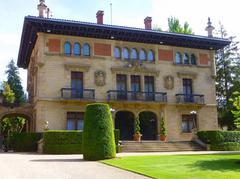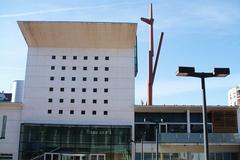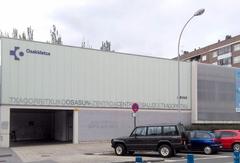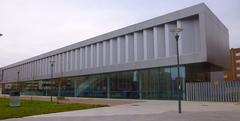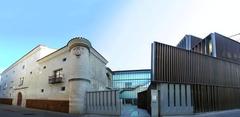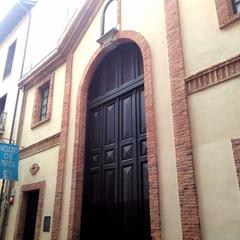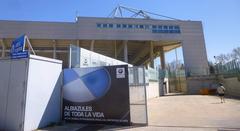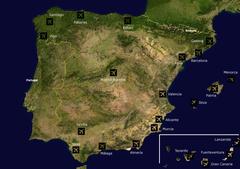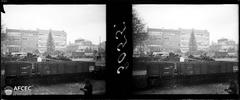
Sancho The Wise: Visiting Hours, Tickets, and Historical Sites in Vitoria-Gasteiz
Date: 04/07/2025
Introduction
Vitoria-Gasteiz, the capital of Spain’s Basque Country, is a city where medieval history, Basque identity, and sustainable modernity converge. Founded in 1181 by King Sancho VI of Navarre—known as Sancho the Wise—the city’s origins and development reflect a legacy of strategic foresight, rich culture, and vibrant urban life (Wikipedia; Coco Tran). This comprehensive guide details the story of Sancho the Wise, highlights must-see historical sites, provides practical information on visiting hours and tickets, and offers tips for exploring Vitoria-Gasteiz sustainably.
Table of Contents
- Foundation of Vitoria-Gasteiz by Sancho the Wise
- Top Historical Sites: Hours and Admission
- Practical Visitor Information
- Sancho el Sabio Vital Fundazioa: A Center for Basque Heritage
- Sustainable Tourism & Responsible Travel in Vitoria-Gasteiz
- Frequently Asked Questions (FAQs)
- Conclusion and Travel Planning Resources
Foundation of Vitoria-Gasteiz by Sancho the Wise
In 1181, Sancho VI of Navarre—Sancho the Wise—established “Nueva Victoria” on the hilltop site of the ancient Basque village of Gasteiz. This move was both strategic and symbolic, strengthening Navarre’s defenses against Castile and laying the groundwork for a thriving urban center (Wikipedia; Rough Guides). The city’s medieval almond-shaped core, with streets named after traditional trades (Correría, Herrería, Zapatería), preserves this legacy (Euskadi Turismo). Over centuries, Vitoria-Gasteiz transitioned from a fortified stronghold to an economic and cultural hub, blending Basque roots with Castilian influences (Coco Tran).
Top Historical Sites: Hours and Admission
Santa María Cathedral
A Gothic masterpiece rising over the Casco Viejo, Santa María Cathedral features soaring spires, archaeological crypts, and panoramic tower views.
- Visiting Hours: Tuesday–Sunday, 10:00 AM–6:30 PM (may vary by season)
- Tickets: €5–€8 for guided tours; free for children under 12. Book online or at the entrance (All About Rosalilla).
- Accessibility: Ramps and assistance for visitors with reduced mobility
Medieval Walls and Defensive Towers
Sections of the original city walls and towers are accessible via guided tours, offering historical insights and city panoramas.
- Hours: Weekends and holidays, check local tourism schedules
- Admission: Tours cost around €6; book in advance during peak season (Coco Tran)
Torre de los Anda and Portalón
These medieval landmarks showcase the city’s defensive architecture and mercantile history.
- Visiting Hours: Tuesday–Sunday, 10:00 AM–5:00 PM
- Tickets: Modest entrance fee; combined tickets available with other sites
Practical Visitor Information
Getting Around & Accessibility
- Walkability: The Casco Viejo is pedestrianized, with moving stairways and elevators connecting lower and upper districts (Audiala)
- Public Transport: Modern trams and eco-friendly buses cover the city; extensive “bidegorri” bike lanes and rentals available
- Accessibility: Most historical sites and public spaces are equipped for visitors with mobility challenges (Coco Tran)
Language & Local Culture
- Languages: Spanish and Basque (Euskara); bilingual signage common
- Tip: Basic Basque phrases like “Eskerrik asko” (“Thank you”) are appreciated (Audiala)
Events, Guided Tours, and Nearby Attractions
- Festivals: Virgen Blanca Festivities in early August feature parades, concerts, and local traditions (Vitoria-Gasteiz Official)
- Guided Tours: Book walking tours focused on Sancho the Wise’s legacy and the city’s transformation (Audiala)
- Nearby: Salburua Wetlands, Artium Museum, and the Green Belt’s parks and trails
Sancho el Sabio Vital Fundazioa: Center for Basque Heritage
History & Mission
Founded in 1964, Sancho el Sabio Vital Fundazioa honors the city’s founder, Sancho VI, and preserves Basque cultural memory. Its collections span manuscripts, maps, drawings, and digital archives from across the Basque regions (Sancho el Sabio Vital Fundazioa; CERL).
Architecture
The center’s award-winning building blends modern glass design with preserved cemetery remains beneath, symbolizing transparency and continuity (Roberto Ercilla Arquitectura).
Collections & Services
- 150,000+ Items: Books, manuscripts (14th century+), maps, periodicals, digital archives (CERL)
- Photographic Archives: Joaquín Jiménez collection documenting Álava from 1957–2005 (Govserv)
- Online Resources: Fully automated catalogs, open-access digital library (Sancho el Sabio Digital Collections)
Visiting Information
- Hours: Mon–Fri, 10:15–13:45 & 16:15–19:15 (August: 8:15–14:45) (CERL)
- Admission: Free; online registration recommended (Sancho el Sabio Registration)
- Contact: +34 945 253932 | [email protected]
- Accessibility: Fully accessible for visitors with disabilities
Events & Community Engagement
- Conferences: “Ikerlariak” and “Arabari buruz” series focus on Basque and Álava history (Sancho el Sabio Activities)
- Exhibitions: “Basques in Australia” and other rotating displays
- Podcasts & Digital Media: Topics on Basque diaspora, history, and culture
Sustainable Tourism & Responsible Travel in Vitoria-Gasteiz
Vitoria-Gasteiz is a model for sustainable urban tourism, awarded European Green Capital (2012) and Biosphere Destination Certification (Biosphere Sustainable). Key initiatives include:
- Green Belt: A ring of parks and wetlands for recreation and biodiversity (The Go Guy)
- Sustainable Mobility: 150+ km of bike lanes, renewable-energy trams and buses
- Eco-Friendly Accommodation: Many hotels carry the Biosphere Certified label
- Local Gastronomy: Pintxos bars and restaurants highlight local, seasonal produce
Responsible Visitor Tips:
- Walk, cycle, or use public transport in the historic core
- Support local businesses and artisans
- Use refillable water bottles and recycle
- Learn and use simple Basque phrases
- Enjoy festivals responsibly and follow sustainability guidelines (Unstoppable Stacey Travel)
Frequently Asked Questions (FAQs)
Q: What are the Santa María Cathedral visiting hours and ticket prices?
A: Tuesday–Sunday, 10:00 AM–6:30 PM; €5–€8 for guided tours; free for children under 12.
Q: Are there guided tours for medieval landmarks?
A: Yes, for the cathedral, walls, and towers. Book in advance for weekend or holiday tours.
Q: How accessible is Vitoria-Gasteiz for those with mobility challenges?
A: The city’s pedestrian zones, ramps, elevators, and public transport make most sites accessible.
Q: When are major festivals held?
A: Virgen Blanca Festivities in early August; Jazz Festival in July.
Q: How do I access Sancho el Sabio Vital Fundazioa’s collections?
A: Onsite during opening hours (free entry, online registration advised) or via their digital library.
Q: What’s the best way to get around sustainably?
A: Explore on foot or by bike in the car-free zones; use trams and buses for longer distances.
Conclusion and Travel Planning Resources
Vitoria-Gasteiz, founded by Sancho the Wise, offers a unique blend of medieval heritage, Basque culture, and green living. Explore iconic sites like Santa María Cathedral, the medieval quarter, and Sancho el Sabio Vital Fundazioa. Take part in local festivals, enjoy Basque cuisine, and experience a city that honors its past while leading in sustainable urban life.
Plan your journey:
- Download the Audiala app for guided tours, digital maps, and up-to-date info (Audiala)
- Book tickets and tours in advance, especially for major sites and festival periods
- Explore additional resources and articles on Basque culture, sustainable travel, and Vitoria-Gasteiz history
Further Reading and References
- Vitoria-Gasteiz (Wikipedia)
- Exploring Vitoria-Gasteiz: Rough Guides
- Coco Tran: Vitoria-Gasteiz Travel Guide
- Sancho el Sabio Vital Fundazioa Official Site
- Roberto Ercilla Arquitectura: Fundazioa Building
- Vitoria-Gasteiz Official Tourism
- Biosphere Sustainable: Vitoria-Gasteiz
- All About Rosalilla: Santa María Cathedral
- Audiala Visitor Guide
Suggested images: Santa María Cathedral, Los Arquillos, Virgen Blanca Festivities, pintxos bars, Sancho el Sabio Vital Fundazioa.
Internal links: Basque culture, sustainable tourism guides, accommodation options.




